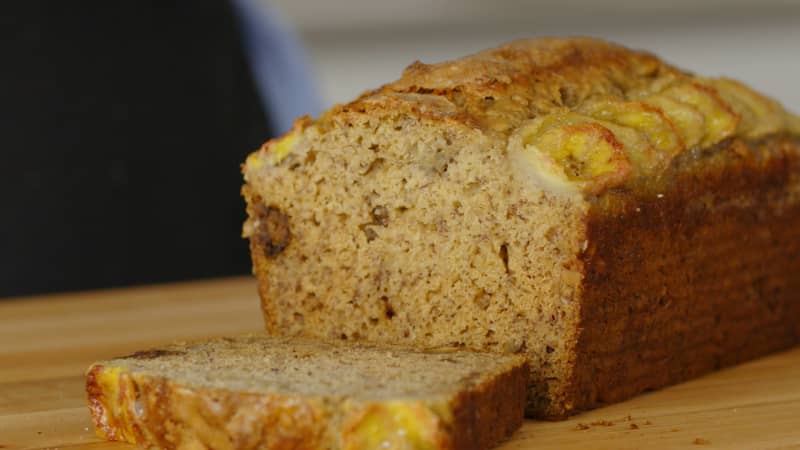When you’ve got a bunch of bananas slowly turning spotty on the countertop, the common course of action is to mash them up and turn them into banana bread. The only problem? Depending on your recipe’s fat-to-flour ratio, and just how spotty your bananas truly are, your bread’s crumb can turn out tough and cottony or dense and damp, usually with a deep brown, overbaked ring crusting over the exterior.
How We Used Science to Make the Most Banana-y Banana Bread
Published June 17, 2022.

Worst of all, most banana breads don’t even taste that much like their namesake fruit. The banana flavor often seems to disappear during baking, leaving a bland loaf that needs cream cheese, rum, chocolate chips, or walnuts to punch it up.
But we at Cook’s Illustrated love nothing more than a challenge, and senior editor Andrea Geary developed a recipe that results in a moist, tender, banana-y loaf every time. The secret? Cramming six whole bananas into the recipe. To learn how she did it, read on: And watch the latest episode of What’s Eating Dan? for more about the science behind it all.
Sign up for the Cook's Insider newsletter
The latest recipes, tips, and tricks, plus behind-the-scenes stories from the Cook's Illustrated team.
The Ripeness of Your Bananas Matters
Great banana bread starts not in your mixing bowl, but in your fruit bowl. Bananas are climacteric, meaning they are picked from the tree when they are mature, but ripen after harvest. This is because picking triggers the release of ethylene gas. Ethylene gas, in turn, triggers a number of changes in the fruit, such as:
- A decrease in acid: This leads to a milder tasting fruit.
- The breakdown of chlorophyll: This changes the bananas from green to yellow.
- The conversion of starch into sugar: This sweetens the banana.
To see just how much this last point matters, we sent bananas at various phases of the ripening cycle to a lab to assess their fructose content. The lightly speckled bananas contained about 1.8% fructose, while the heavily speckled ones contained 5.3% fructose.
So, when it comes to making banana bread, patience is a virtue—don’t even think about baking with your bananas until they’ve got plenty of brown speckles.
How to Make 6-Banana Banana Bread
So, you’ve got a perfect bunch of heavily speckled bananas—now how do you fit them all into one banana-packed loaf? Here’s Andrea’s method.
1. Microwave 5 bananas and strain off the liquid. You should get about ½ to ¾ cup banana juice.
2. Place the juice in a saucepan and reduce it to about ¼ cup to concentrate the sweetness and the banana flavor.
3. Add the bananas back to the liquid. Mash until smooth, then add butter, eggs, brown sugar, and vanilla.
4. Add the wet ingredients to a bowl of flour, baking soda, and salt. Fold until only streaks of flour remain.
5. Pour the batter into a loaf pan.
6. Peel and slice your last banana. Shingle the slices on top of the loaf, then rain sugar down on top of the slices and the loaf to help the top of the loaf caramelize.
After about an hour in the oven, you’ll have a perfectly moist, lightly sweetened, fruit forward loaf. Get the full recipe here:
Ultimate Banana Bread
Any 10-year-old can make the typical dry, bland banana bread. But if you want to make a moist, tender loaf with over-the-top banana flavor, you need to think like a scientist.Going bananas for bananas? Watch the full episode of What’s Eating Dan? below.

